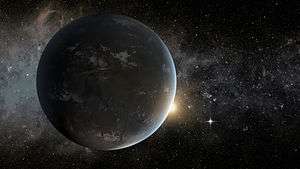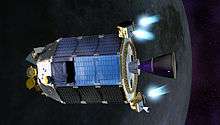Kepler-91b
| Exoplanet | List of exoplanets | |
|---|---|---|
| Parent star | ||
| Star | Kepler-91 | |
| Constellation | Lyra | |
| Right ascension | (α) | 19h 02m 41.0s |
| Declination | (δ) | +44° 07′ 00″ |
| Apparent magnitude | (mV) | 12.9 |
| Distance | 3360 ly (1030±150 pc) | |
| Mass | (m) | 1.31±0.1 M☉ |
| Radius | (r) | 6.3±0.16 R☉ |
| Temperature | (T) | 4550±75 K |
| Metallicity | [Fe/H] | 0.11±0.07 |
| Age | 4.86±2.13 Gyr | |
| Physical characteristics | ||
| Mass | (m) | 0.88+0.33 −0.17 MJ |
| Radius | (r) | 1.322+0.094 −0.086 RJ |
| Geometric Albedo | (Ag) | 0.39 [1] |
| Density | (ρ) | 0.44 g cm−3 |
| Temperature | (T) | 2132 K |
| Orbital elements | ||
| Semi-major axis | (a) | 0.072+0.007 −0.002 AU |
| Orbital period | (P) | 6.24658 d |
| Inclination | (i) | 68.5+1.6 −1° |
| Discovery information | ||
| Discovery date | 2013 | |
| Discoverer(s) | ||
| Discovery method | Transit (Kepler Mission) | |
| Other detection methods | Ellipsoidal light variations Reflection/emission modulations | |
| Discovery status | Confirmed | |
| Other designations | ||
| KOI 2133.01
| ||
Kepler-91b is a planet orbiting Kepler-91, a star slightly more massive than the Sun. Kepler-91 has left the main sequence and is now a red giant branch star.
Discovery and further confirmation
Kepler-91b was detected by analyzing the data of Kepler spacecraft where a transit-like signal was found. Initially thought to be a false positive due to light curve variations by a self-luminous object, it was later revealed that due to low density of Kepler-91's shape is distorted to slightly ellipsoidal shape due to gravitational effects of the planet. Ellipsoidal light variations caused by Kepler-91b constitute more than the third of light variations compared to transit depth. Ellipsoidal light variations also allowed to determine the planet's mass. It was also found that Kepler-91b reflects some of the starlight from its star.[2]
Further analysis managed to question the planetary nature of the object, suspecting that it is a self-luminous object. However, the planetary nature was eventually confirmed again.[3]
Characteristics
Kepler-91b is about 14% less massive than Jupiter while being more than 35% larger, making it less than half of the density of water. Kepler-91b orbits around the host star in about 6.25 days. Despite being one of the least edge-on orbits relative to Earth with inclination being about 68.5 degrees, transit was detected due to low semi-major axis to host star radius ratio.
Kepler-91b is expected to be engulfed by the parent star within about 55 million years.[2][1]
Possible trojan companion
The possibility of a trojan planet to Kepler-91b was studied but the conclusion was that the transit-signal was a false-positive.[4]
References
- 1 2 Esteves, Lisa J.; De Mooij, Ernst J. W.; Jayawardhana, Ray (2014). "Changing Phases of Alien Worlds: Probing Atmospheres of Kepler Planets with High-Precision Photometry". The Astrophysical Journal. 804 (2): 150. arXiv:1407.2245
 . Bibcode:2015ApJ...804..150E. doi:10.1088/0004-637X/804/2/150.
. Bibcode:2015ApJ...804..150E. doi:10.1088/0004-637X/804/2/150. - 1 2 Lillo-Box, J.; Barrado, D.; Moya, A.; Montesinos, B.; Montalbán, J.; Bayo, A.; Barbieri, M.; Régulo, C.; Mancini, L.; Bouy, H.; Henning, T. (2013). "Kepler-91b: A planet at the end of its life. Planet and giant host star properties via light-curve variations". Astronomy & Astrophysics. 562: A109. arXiv:1312.3943
 . Bibcode:2014A&A...562A.109L. doi:10.1051/0004-6361/201322001.
. Bibcode:2014A&A...562A.109L. doi:10.1051/0004-6361/201322001. - ↑ Sliski, David H.; Kipping, David M. (2014). "A High False Positive Rate for Kepler Planetary Candidates of Giant Stars using Asterodensity Profiling". The Astrophysical Journal. 788 (2): 148. arXiv:1401.1207
 . Bibcode:2014ApJ...788..148S. doi:10.1088/0004-637X/788/2/148.
. Bibcode:2014ApJ...788..148S. doi:10.1088/0004-637X/788/2/148. - ↑ Placek, Ben; Knuth, Kevin H.; Angerhausen, Daniel; Jenkins, Jon M. (2015). "Characterization of Kepler-91b and the Investigation of a Potential Trojan Companion Using EXONEST". The Astrophysical Journal. 814 (2): 147. arXiv:1511.01068
 . Bibcode:2015ApJ...814..147P. doi:10.1088/0004-637X/814/2/147.
. Bibcode:2015ApJ...814..147P. doi:10.1088/0004-637X/814/2/147.


